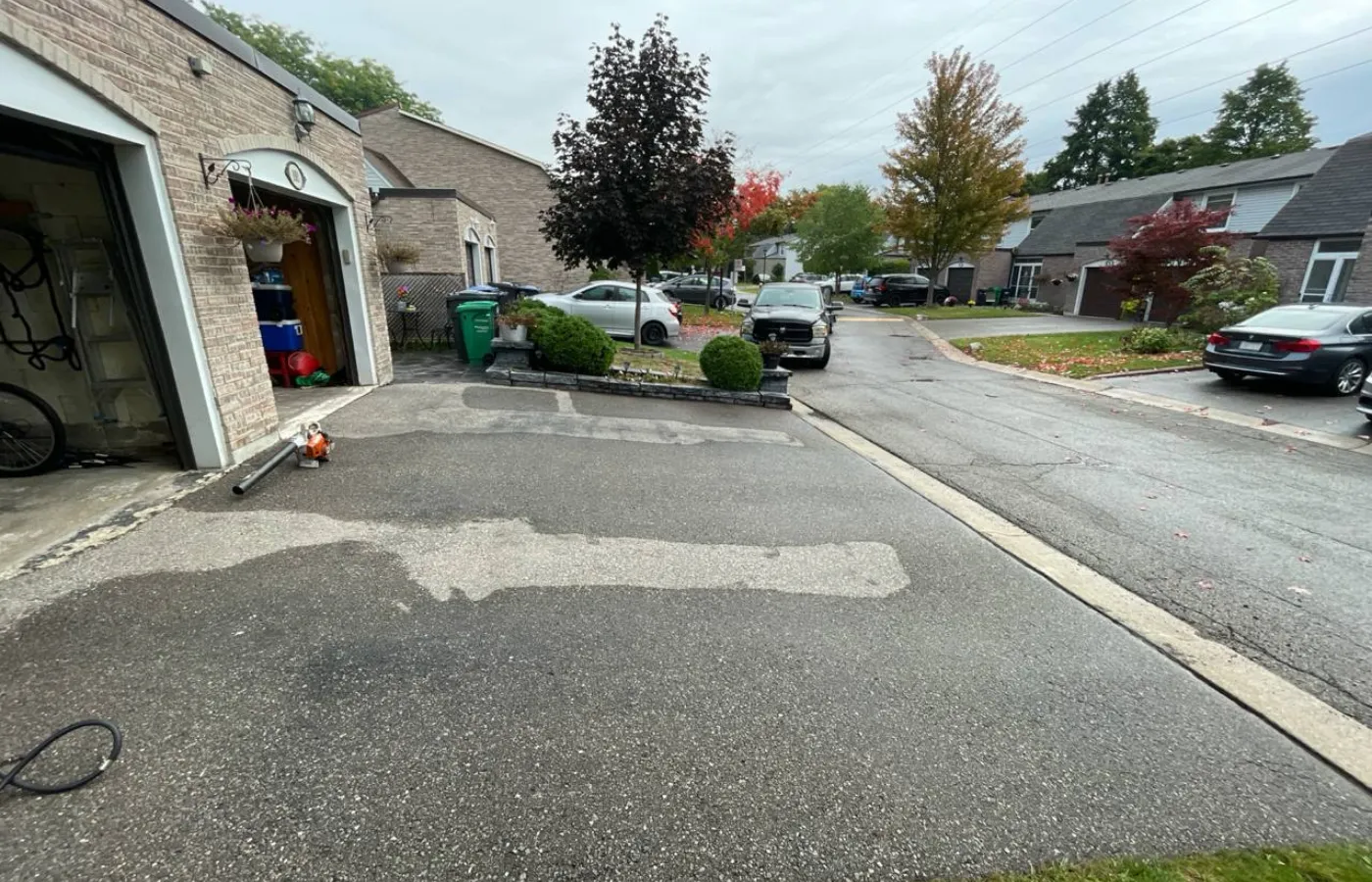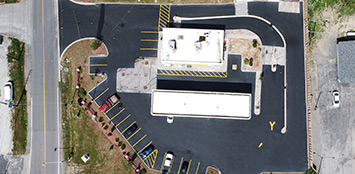Asphalt driveways and parking lots are a significant investment, protecting them is critical for long-term performance. One of the most effective ways to maintain and extend the life of your newly paved asphalt driveway or commercial space is through proper sealing. However, what many property owners overlook is how much of a role weather, specifically rain, can play in the success or failure of that asphalt sealant. For anyone in the GTA, where the weather is notoriously unpredictable, understanding the interaction between rain and sealant life is not just useful, it’s essential.
The High Stakes of Weather: Why Timing In Sealing Your Asphalt Matters
Rain can drastically undermine the effectiveness and durability of asphalt sealant. If moisture hits at the wrong time, it can prevent the sealant from bonding properly, weaken its protective barrier, and ultimately cut the sealant’s life short. Navigating these challenges is key to protecting your investment and avoiding unnecessary costs.
What Happens If It Rains During Application?
The first and most critical mistake is applying sealant while it’s raining. This is a major concern because it is designed to bond to dry asphalt sealants on driveways, creating a protective layer that guards against water, oil spills, and UV rays.
The Risk:
When rain falls during application, the water dilutes the sealant immediately, preventing it from setting into the surface. Instead of forming a strong shield, the sealant can wash away in streaks, leaving behind a patchy and uneven coat that offers little to no protection.
The Result:
- Washed-away areas that expose raw asphalt
- Immediate need to reapply, doubling your time and cost
- Risk of slippery, unsafe surfaces due to pooling sealant and water
For residents of the GTA, where pop-up showers are common even on seemingly clear days, this is a real headache that often leads to frustration and extra expense.
Rainfall Before the Sealant Has Fully Cured
Even if you’re able to have the sealant put on in a dry environment, you’re not in the clear until the sealant is completely cured. Most asphalt sealants will take anywhere from 12 to 48 hours to completely harden and dry, depending on the type of sealant you use and weather conditions in your area.
What Happens When Rain Hits Too Soon:
- The water disrupts the curing of the sealant, so the areas become weak with the sealant not being able to bond properly.
- Streaks, discoloration, or even peeling patches are easily visible.
- The whole barrier is compromised, exposing your asphalt to early wear and tear. In Toronto weather, unexpected rain showers are notorious for spoiling otherwise excellent sealing jobs. This is a huge inconvenience because even if the surface appears to be fine initially, problems can occur months later, leading to cracks, potholes, and outright resurfacing that could have been prevented.
Long-Term Effects: Compromising the Sealant Life
Applying sealant on a damp surface or in unpredictable weather doesn’t just affect the immediate look; it dramatically shortens the lifespan of your sealant. The protective layer that is supposed to keep water, chemicals, and oxidation at bay becomes weak and brittle, sometimes failing within a single season.
Key Risks of Weak Sealant:
- Increased water penetration leading to foundational cracks
- Higher susceptibility to freeze-thaw cycles, especially in Toronto winters
- Premature deterioration, meaning costly repairs or resealing much sooner than expected
Failing to ensure optimal curing conditions could mean your sealant, which should ideally last 2-3 years, fails within months, turning what should have been preventative maintenance into an ongoing problem.

Optimal Conditions vs. Risks For Asphalt Sealant
Factor |
Optimal Condition |
Rain Risk |
Sealant Life Impact |
| Application Timing | Dry weather, 0% chance of rain | Rain during application | Immediate failure, full reapplication needed |
| Surface Condition | Completely dry asphalt surface | Damp/wet surface | Poor adhesion, streaking, patchy areas |
| Curing Time | 24–48 hours rain-free post-application | Rain within 12–24 hours | Weak bond, shortened lifespan |
| Type of Sealant | High-quality oil-based | Low-quality or water-based in rainy areas | Lower resistance, higher failure risk |
| Temperature | 15°C–27°C ideal | Below 10°C or above 30°C, combined with rain | Slower cure, weakened durability |
How to Avoid Rain-Related Issues In Sealing
- Always Check the Weather Forecast: Before scheduling your sealing job, seek at least a 48-hour dry window. It’s a good idea to follow multiple weather services to be sure no unexpected rain is likely.
- Prepare the Surface Thoroughly: Even morning dew or excessive humidity can create moisture that interferes with adhesion. Make sure the surface is bone-dry before any sealant touches it.
- Choose the Right Season: Late spring through early fall in Toronto typically offers the most dependable weather. Aim for mid-season months when the temperature is steady, and rainfall is historically lighter.
- Apply Quality Sealants: Not all sealants are created equal. High-quality, oil-based products are more forgiving if humidity rises unexpectedly after application. Avoid cheap, water-based options if you’re in an area prone to sudden weather shifts.
- Have a Contingency Plan: Hire the services of an expert crew that has the expertise to tackle unexpected weather challenges. We at Asphalt Sealing pride ourselves on being highly planned and solution-driven in advance to make your sealing project withstand even unexpected weather.
What to Do If Rain Disrupts Your Sealing Process
Despite proper planning, Toronto’s unpredictable weather can throw a curveball. In the event that rain suddenly falls after asphalt sealant application, it is crucial to move fast to prevent permanent damage. Having the right steps can save you from costly repairs and extend the sealant’s life.
Step 1: Conduct a Complete Surface Inspection
After the rain has subsided and the surface is totally dry, slowly walk the whole driveway or parking lot. Watch for streaks, colour unevenness, or any sections where the sealant is thin or washed off. These are characteristic signs that rain disrupted the curing process.
Step 2: Assess the Damage to the Asphalt Sealant
Not all rain showers condemn you. Light rain may lead to slight cosmetic streaking that does not require urgent attention. However, if you notice widespread peeling, large bare spots, or the sealant is patchy across large areas, this is an indication. These surfaces have lost their protective film and are in danger of premature cracking and erosion.
Step 3: Call for Professional Help to Avoid Guesswork
It’s simple to assume it’s all fine if it looks fine most of the time, but hidden weak spots have a tendency to become giant issues down the road. Getting an asphalt protection professional to check it out ensures a qualified opinion. A good crew will let you know whether a spot-up will suffice, or if you’ll need to reapply completely to maintain your asphalt in working order.
The True Cost of Ignoring Asphalt Sealant Damage
It is perhaps a small fault to be left with small streaks or patches after a rainy setback, but the financial effect can be staggering. Once the waterproof seal of the sealant is broken, water seepage begins immediately. It eventually leads to deep cracks, potholes, and base layer deterioration that need expensive repairs or even full resurfacing.
In Toronto, where weather conditions are extreme, the stakes are higher. A breached sealant beckons frost damage during winter, with expansion and contraction aggravating the inherent flaws. What would have been a speedy repair is now a monstrous expense in a matter of months.
The takeaway: Skipping the proper maintenance now will be more expensive later. Prioritize sealant life and protect your property by repairing damage quickly and professionally.
Protect Your Asphalt Sealant Investment
Rain is disastrous to fresh, sealed asphalt, but by using smart planning and quick action, you can minimize the risks. Preparation and addressing professionals who are aware of the intricacies of Toronto’s climate are the secrets.
Sealcoating your parking lot or driveway in perfect conditions, with proper curing, forms a robust armour, extending the life of your asphalt and saving you thousands on future repairs. Don’t neglect the power of timing, good materials, and professional work to keep your asphalt shielded year after year.
For asphalt coatings that will stand up to anything Toronto’s weather throws at them, trust the professionals at Asphalt Sealing. We don’t just apply sealant, we strategize, plan, and execute with precision to maximize your sealant life and give you peace of mind. Contact us today for a no-obligation assessment and discover how we make asphalt protection easy and reliable.



